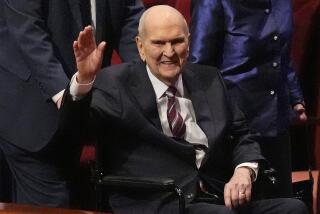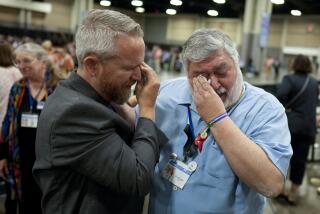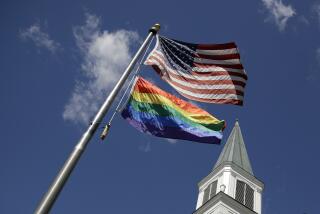Mormon Church Passes 7-Million Mark : Growth: Its missionaries total 40,000 around the globe. But analysts say 40% of the church’s membership is inactive.
Continuing to win converts at an impressive pace, the Mormon Church recently announced that it passed the 7-million mark in worldwide membership late last year.
Little surprise there: The litany of growth recited by the Salt Lake City-based church in the post-World War II era is as steady as the repertoire of the Mormon Tabernacle Choir.
- Global membership has climbed sevenfold since 1947. A U.S. membership of nearly 4.5 million makes it the sixth largest religious denomination in the country.
- Young Mormon missionaries on two-year stints now number 40,000 around the globe--10,000 more than a decade ago. They accounted for 256,000 converts in 1988, and when final figures are compiled, the number may exceed 300,000 for 1989.
- One prominent, non-Mormon scholar recently repeated his forecast that the Mormon Church will be a major world faith of 60 million members by the year 2080.
Nevertheless, a behind-the-scenes debate has developed over whether the parade of numbers hides a troublesome trend for the Church of Jesus Christ of Latter-day Saints, the formal name of the tightly run, image-conscious religious body.
Several analysts familiar with the church contend that at least 40% of Mormons are inactive--many of them members in name only, if not disenchanted with Mormonism.
In what he called a “dilemma of slippage,” sociologist Armand L. Mauss of Washington State University, a Mormon himself, said in an interview that “not more than half of the converts in any year will be active members five years later,” according to what he hears from church researchers.
During a convention of religious sociologists in Salt Lake City in October, British scholar Eileen Barker said only 20% of Mormon converts stay involved with the church in her country. Sociologist Larry Young of Mormon-run Brigham Young University said at the same meeting that “it can be argued that there has been a slippage in retaining members.”
Non-Mormon historian Jan Shipps of Indianapolis, a respected authority on the church, concurred in an interview that indications are that “at least 40% of new converts drift away.” She emphasized that the drift is a phenomenon normally experienced by large religious bodies.
Researchers inside and outside the church have been frustrated, however, by the fact that despite the voluminous reports sent to Salt Lake City, no figures have been released on how many people--whether converts or Mormons born into the church--are inactive members.
Jerry Cahill, a church spokesman, said this week that Mormon leaders have “no reliable studies on retention of converts, or at least none that the (ruling) Council of Twelve puts stock in.”
But Cahill also said the concern over inactive members has been strong throughout Morman history, going back to its founding by Joseph Smith in 1830. He noted, however, that the current President-Prophet Ezra Taft Benson, shortly after his installation in 1985, put added emphasis on trying to attract disaffected Mormons back to church.
Indeed, “great energy is expended to try to reactivate people,” said Keith Atkinson, the Los Angeles-based spokesman for 700,000 California Mormons. Atkinson said he had heard estimates of 40% to 50% inactive members “bandied about.” But he said he was surprised to learn this week that inactive ranks are lower, averaging about 30% of membership, in three “stakes,” or regional jurisdictions, in the greater Los Angeles area
Howard B. Anderson, president of the 3,200-member Los Angeles Stake, covering downtown and Hollywood, said his experience in various U.S. cities shows that dedicated, contributing members make up a third. Another one-third are “attenders” whose participation varies greatly, he said, and the remaining one-third “never set foot inside the church.”
The Mormon Church keeps better records of its inactive members than do most religious bodies.
“Once you are baptized into the church, that is recorded as part of a permanent record of your eternal progress . . . ,” Anderson said. “You never disappear once you’re in the records of the church unless disciplinary measures were taken or your name is removed at your own request.”
In his stake, Anderson said, only a handful of people each year are excommunicated or request that their names be removed. The church simplified the latter process last year, requiring only a letter requesting removal and a wait of 30 days.
The meticulous record-keeping and attention to inactive members was confirmed by a retired business executive living in Orange County, who has not been involved in Mormon activities for nearly 20 years.
“I can move away, but it always seems that they find you,” he said, adding that the contact is always courteous. “(Mormon) teachers are required to come by every month or so. Their stated purpose is to look after the welfare of the families that they are responsible for.”
The man, who asked that his name not be used, said he has an intellectual disaffection with the church. But he said he has not removed his name from the rolls for fear of upsetting family members long active in the church.
A representative of the antagonistic Ex-Mormons for Jesus said she knows of people who have been attending Protestant churches for 10 to 15 years who are still listed as members of the Mormon Church.
“I tend to feel that (the Mormon membership figures) are bogus numbers,” said Claudette Woodhouse, a board member of Southern California Ex-Mormons for Jesus.
However, J. Gordon Melton, director of the Institute for the Study of American Religion in Santa Barbara, said most calculations of religious membership include great numbers of inactive people, since few church bodies clean their rolls fully of members who are never seen at services.
The growth of a religious institution also can be measured by its spread of active centers and buildings, Melton said. “In that sense, the growth of Mormonism is very real.”
MORMON CHURCH GROWTH WORLDWIDE It took the Mormon Church 16 years to gain its second million members (1n 1963), but only three years to grow from 6 to 7 million. 1947: 1 million members 1963: 2 million 1971: 3 million 1978: 4 million 1982: 5 million 1986: 6 million 1989: 7 million Source: Church of Jesus Christ of Latter-day Saints
More to Read
Sign up for Essential California
The most important California stories and recommendations in your inbox every morning.
You may occasionally receive promotional content from the Los Angeles Times.










